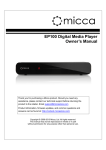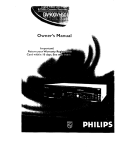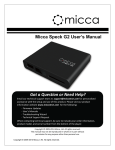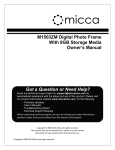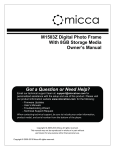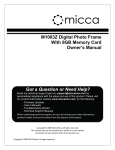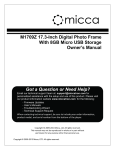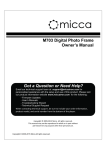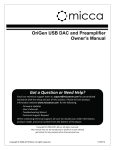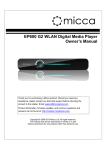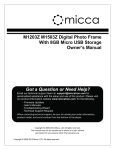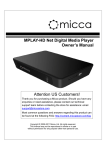Download Micca MPLAY-HD 1080P Owner`s manual
Transcript
MPLAY-HD WLAN Digital Media Player Owner’s Manual Got a Question or Need Help? Email our technical support team at: [email protected] for personalized assistance with the setup and use of this product. Please visit our product information website www.miccatron.com for the following: - Firmware Updates - User’s Manuals - Troubleshooting Wizard - Technical Support Request When contacting technical support, be sure to include your order information, product model, and serial number from the bottom of the player. Copyright © 2009-2014 Micca. All rights reserved. This manual may not be reproduced in whole or in part without permission for any purpose other than personal use. Copyright © 2009-2014 Micca. All rights reserved. Copyright © 2009-2014 Micca. All rights reserved. 1 Introduction 1.1 Preface Thank you very much for purchasing this media player. We hope you will enjoy using it as a great home entertainment device. This player has the following functionality: 1.1.1 A/V Output HDMI for high-definition video and digital audio Composite video and stereo audio for analog A/V connection S/PDIF optical interface for high-fidelity digital audio Adjustable video output resolution (NTSC, PAL, 480p, 576p, 720p, 1080i, 1080p) 1.1.2 Multimedia Playback Supports major audio, video and image file formats (1080p HD video decoding) Video format: MKV, AVI, MOV, MP4, WMV, MPG, VOB, DVD/BD-ISO, M2TS, TS, DAT, RM/RMVB Subtitle format: SRT, SMI, SSA,SUB, IDX+SUB Audio format: MP3, OGG, WMA, WAV, FLAC, APE Photo format: JPG, GIF, BMP, PNG, TIF 1.1.3 Network Feature 10/100Mbps Ethernet LAN, 300mbps* 802.11n WLAN (*Actual transfer speed may vary due to interference, router distance, environment, network conditions, and other factors.) Stream media from network shares and UPnP media servers Cast screen function for A/V mirroring using compatible smartphones and tablets DLNA digital media renderer capability 1.1.4 Storage Support USB 2.0 HOST ports (3) for connecting USB storage devices Memory card reader supports SD and SDHC memory cards up to 32GB Supports USB drives using FAT/FAT32, NTFS, HFS+, and EXT3 file system up to 2TB Note: All the information contained in this manual was correct at the time of publication. However, as our engineers are always updating and improving the product, your device’s software may have a slightly different appearance or modified functionality than presented in this manual. Copyright © 2009-2014 Micca. All rights reserved. Page | 1 1.2 Precautions This player’s design has your safety in mind. In order to safely and effectively use this player, please read the following before usage. 1.2.1 Usage Cautions Users should not modify this player. If a commercial hard disk drive is being used, the environmental temperature should be between 40 to 95 degrees Fahrenheit. 1.2.2 Power The player’s power supply voltage is within the range of DC 5V-5.4V 2A. When using this player, please connect the supplied AC adapter or AC adapter cable to the player’s power jack. When placing the adapter cable, make sure it is not damaged or subject to pressure. To reduce the risk of electric shock, unplug the adapter first before cleaning it. Never connect the adapter to the player in a humid or dusty area. Do not replace the adapter or cable’s wire or connector. 1.2.3 FCC Statement 1. This device complies with Part 15 of the FCC Rules. Operation is subject to the following two conditions: (1) This device may not cause harmful interference. (2) This device must accept any interference received, including interference that may cause undesired operation. 2. Changes or modifications not expressly approved by the party responsible for compliance could void the user's authority to operate the equipment. NOTE: This equipment has been tested and found to comply with the limits for a Class B digital device, pursuant to Part 15 of the FCC Rules. These limits are designed to provide reasonable protection against harmful interference in a residential installation. This equipment generates uses and can radiate radio frequency energy and, if not installed and used in accordance with the instructions, may cause harmful interference to radio communications. However, there is no guarantee that interference will not occur in a particular installation. If this equipment does cause harmful interference to radio or television reception, which can be determined by turning the equipment off and on, the user is encouraged to try to correct the interference by one or more of the following measures: Reorient or relocate the receiving antenna. Increase the separation between the equipment and receiver. Connect the equipment into an outlet on a circuit different from that to which the receiver is connected. Consult the dealer or an experienced radio/TV technician for help. FCC Radiation Exposure Statement Copyright © 2009-2014 Micca. All rights reserved. Page | 2 This equipment complies with FCC radiation exposure limits set forth for an uncontrolled environment. This equipment should be installed and operated with minimum distance 20cm between the radiator & your body. 1.2.4 Disposing of the Player When you dispose of the player, be sure to dispose it appropriately. Some countries may regulate disposal of electrical device, please consult with your local authority. 1.2.5 Additional Precautions When using this player, please do not let the player come into contact with water or other liquid. If water is accidentally spilled on the player, please use a dry cloth to absorb the spillage. Electronic products are fragile. Please be gentle during use; avoid shaking or hitting the player, and do not press the buttons too hard. Do not let the player come into contact with water or other liquids. Do not disassemble, repair or change the design of the player, any damage done will not be included in the repair policy. Do not press the buttons of the player too hard. Avoid hitting the player with hard objects, shaking the player, and stay away from magnetic fields. Electrostatic discharge may cause the product to malfunction. When this happens, unplug the power cable and the product will return to normal operation next time it is powered on. Copyright © 2009-2014 Micca. All rights reserved. Page | 3 2 Player and Remote Overview 2.1 Connections and Ports Name 1 DC IN 2 UPGRADE 3 OPTICAL 4 AV 5 HDMI 6 7 8 LAN USB1 WLAN 9 10 USB2, USB3 SD/SDHC Description DC power input, 5-5.4V. Only use the AC adapter provided with the player. Pin-hole button for performing firmware. See ‘8.5.3 USB Upgrade’ for more information. S/PDIF optical digital audio output to a home theater receiver with optical audio input. Composite video and analog Left/Right audio output to a TV or home theater with analog A/V input. Provides digital audio/video to a TV or home theater with HDMI input. 10/100Mbps Ethernet for local area network access. USB 2.0 host jack for connecting USB storage drives. WLAN antenna for local network access. Up to 300Mbps; Actual transfer speed may vary due to interference, router distance, environment, network conditions, and other factors. USB 2.0 host jacks for connecting USB storage drives. Memory card reader for SD/SDHC memory cards. Copyright © 2009-2014 Micca. All rights reserved. Page | 4 2.2 Remote Control All player functions can be controlled by using the remote control. See the following for details on the function of each button. Button POWER HOME RED, GREEN CAST EJECT GOTO REPEAT INFO ZOOM MENU 1. POWER 2. HOME 3. RED 4. GREEN 5. CAST 6. EJECT 7. GOTO 8. REPEAT 9. INFO 10. ZOOM 11. MENU 12. RETURN 13. DIRECTIONAL KEYS 14. OK/ENTER 15. SUBTITLE 16. AUDIO 17. REWIND 18. PLAY/PAUSE 19. FAST FORWARD 20. PREVIOUS 21. STOP 22. NEXT 23. SETUP 24. TV SYSTEM 25. SLOW 26. MUTE 27. VOLUME- 28. VOLUME+ Description Power on/off the player Return to the main menu Context buttons; Function will be noted on-screen when available. Start cast screen feature Detach a storage device for safe removal. Jump to a specific time in a video during playback Set repeat option for the current playback Display information about the currently playing file Zoom in when viewing photos or change screen aspect ratio when playing videos Access the menu for the current function. Menu is context sensitive and will be different depending on function. Copyright © 2009-2014 Micca. All rights reserved. Page | 5 Button RETURN DIRECTIONAL KEYS OK/ENTER SUBTITLE AUDIO REWIND and FAST FORWARD PLAY/PAUSE STOP PREVIOUS and NEXT SETUP TV SYSTEM SLOW MUTE VOL+/VOL- Description Press to return to the previous screen when navigation menus. Press to exit the current folder when browsing files. Navigate onscreen menu items to highlight items Select or confirm the highlighted item Access the subtitle settings menu when playing videos Change audio track when playing videos Press to rewind or fast forward the current playback. Press repeatedly to change rewind or fast forward speed. Begin or pause playback Stop playback Press to go to previous/next page in file browser. Press to go to previous/next chapter during BD/DVD playback. Press to go to previous/next file during video playback. Enter the setup menu to change player settings Switch between available video output modes: NTSC, PAL, 480p, 576p, 720p, 1080i/p Slow down playback when playing videos Mute audio output; press again to unmute. Change the output volume. (Hint: Set volume to max and use the TV or AV receiver to control volume). Copyright © 2009-2014 Micca. All rights reserved. Page | 6 3 Connections 3.1 Basic Connections 3.1.1 Connecting power Only use the AC adapter that is supplied with the player. Connect the barrel connector of the AC adapter to the player’s DC IN jack. The player will power on automatically whenever power is connected. To turn the player off, use the POWER button on the remote control. 3.1.2 Connecting a USB Storage Device Storage devices such as USB hard drives or flash drives can be connected to the player for playback of media files. Plug in the USB device to one of the USB HOST ports on the player. After about 5-10 seconds, the USB drive will be detected and accessible by the player. 3.2 Audio and Video Connections The player can be connected to a TV/HDTV or home theater system in a variety of methods. For best results, always use the best method available for connection: Best Video HDMI Audio HDMI Better HDMI Digital optical Good Composite Video Composite Video Digital optical Okay Analog L/R Requirement TV with HDMI input and home theater receiver that can decode audio over HDMI. TV with HDMI input and home theater receiver with optical input. TV with composite input and home theater receiver with optical input. TV with composite video and analog audio inputs. 3.2.1 HDMI Connection HDMI provides the best possible video and audio connection. Use this connection whenever possible. 1) Plug one end of the HDMI cable to the player’s HDMI output jack and the other end of the HDMI cable to a HDMI input jack on the TV or home theater receiver. 2) Configure the player’s video output according to ‘8.3.2 TV System’ of this manual. 3) Configure the player’s audio output according to ‘8.2.1 HDMI Output’ of this manual. 4) Consult the TV or home theater receiver’s manual for configuring its HDMI inputs. 3.2.2 Digital Audio Connection When using a home theater receiver or sound system that lacks HDMI input, the player’s optical digital audio output can be used. 1) Plug one end of the Toslink optical cable to the player’s optical output jack and the other end of the cable to the home theater receiver or sound system’s optical input jack. Copyright © 2009-2014 Micca. All rights reserved. Page | 7 2) Configure the player’s optical audio output according to ‘8.2.2 Optical (S/PDIF) Output’ of this manual. 3) Consult the receiver or sound system’s manual for configuring its optical inputs. 3.2.3 Composite Video and Analog Audio Connection When using a TV that only has composite video input, the player’s composite video and analog L/R audio output can be used. 1) Plug the 3.5mm connector of the red/white/yellow AV cable to the player’s AV output jack and the other end of the red/white/yellow AV cable to an available AV input on the TV. 2) Configure the player’s video output according to ‘8.3.2 TV System’ of this manual. 3) Consult the TV’s manual for configuring its AV inputs. 3.3 Network Connections 3.3.1 Connecting to a Wired LAN Network A wired Ethernet connection provides the best results for streaming media content through the network. Use a wired Ethernet connection whenever it is possible to do so. 1) Plug one end of a Cat5/5e/6 Ethernet network cable to the player’s LAN jack. 2) Plug the other end of the Cat5/5e/6 Ethernet network cable to an available port on a LAN switch, router, or networked wall plate. The player auto detects LAN network settings in most cases without requiring any additional configuration. Advanced users can refer to ‘8.4 Network Settings’ for more details on manual network configuration. 3.3.2 Connecting to a Wireless Network When a wired network connection is not available, the player can stream A/V content through the network by using 802.11n WLAN connectivity. 1) Unplug any LAN cables from the player. The player will only use WLAN if LAN is not connected. 2) Configure the player’s WLAN according to ‘8.4 Network Settings’ of this manual. Note: A/V streaming performance over WLAN is highly dependent on location, distance to router, the number of floors and walls in the signal path, other 2.4GHz devices in the area, and other such variables that differ on a case by case basis. It may be difficult to reliably stream HD quality 1080p videos over a WLAN connection even if the signal strength appears to be strong. Always use a wired Ethernet LAN connection when available. Copyright © 2009-2014 Micca. All rights reserved. Page | 8 4 First Time Startup 4.1 Power On After connecting the AC power adapter to the player’s DC IN jack for the first time, the player turns on automatically. To turn the player on/off, use the POWER button on the remote control. 4.2 Initial Setup When turning on the player for the first time, it will prompt the user to select the menu language, time, and wired LAN settings. 4.2.1 Language Choose the desired language. This is the language that will be used for menus and interface. 4.2.2 Time Setting the time of the player is optional, as the player will automatically set its own time when an Internet connection is available. To set the time, first select Time Zone relative to GMT. Next the user is prompted to enter the date and time. If you skip this step, please refer to ‘8.1.3 Time’ for instructions on how to set the player’s time through the Settings menu. 4.2.3 Wired LAN This step of the initial setup is optional. Refer to ‘8.4 Network Settings’ for more details about network setup. If the user skips this step during initial setup, the settings can be performed through the player’s Settings menu. For most cases, the “DHCP IP (Auto)” setting is the correct setting. Only advanced users should choose the “FIX IP (Manual)” setting. Copyright © 2009-2014 Micca. All rights reserved. Page | 9 4.2.4 Additional Setup After the initial setup, it’s strongly recommended that the player’s video output resolution be set to match the TV’s resolution. Please refer to ‘8.3.2 TV System’ for more details on configuring the player’s video output. 4.2.5 Main Menu When the initial setup is complete, the player will display the main menu. The main menu contains icons that represents player functions available for use. The main menu items have the following functionality: Menu Item Videos Photos Music All Cast Screen Setup Description Browse and play video files Browse and view photos Browse and play music files Browse and play all supported media types Start the cast screen feature Access the setup menu to change player settings Copyright © 2009-2014 Micca. All rights reserved. Page | 10 5 Browsing Media Files After selecting the Videos, Photos, Music, or All icon from the main menu, the file browser interface is displayed for finding media files on USB drives, memory cards, network folder shares, or UPnP servers. Media files will be listed in their original folder structure. A variety of storage devices and network media sources are supported by the player. Only those sources that are connected and detected by the player will be listed: Menu Item USB DVD Network UPnP Card Description Browse media files on an external USB drive attached to the player. Browse media files on an attached DVD drive. Browse media files on LAN folder shares. Browse media files on UPnP servers. Browse media files on a SD/SDHC memory card. After selecting a storage device, media files will be displayed in the same folder structure as they are stored. Use the directional LEFT/RIGHT and UP/DOWN buttons on the remote control to select folders or files and press OK/ENTER to enter a folder. When there is a large number of files or folders listed, use the PREV/NEXT buttons to scroll through files/folders one page at a time. To exit from a folder, press the RETURN button. To play a media file, highlight it and press the OK/ENTER button. Videos stored as BD/DVD folders have multiple sub folders and video files stored within a nested folder structure. By default, pressing OK/ENTER will navigate within the folder. To play the entire BD/DVD folder, highlight the folder and press the PLAY/PAUSE button. Copyright © 2009-2014 Micca. All rights reserved. Page | 11 5.1 Media File Display Modes To make it easier and more intuitive to browse media files, three different media display modes are available: Thumbnail, List, and Preview. To change the display mode, press the MENU button on the remote to bring up the options menu and select the desired display mode 5.1.1 Thumbnail View Thumbnail view displays folders and media files as thumbnails on the screen with a partial file name underneath. This is useful for browsing photos and movies with associated cover art. The player will use the first JPG image file found in each folder as its thumbnail. Copyright © 2009-2014 Micca. All rights reserved. Page | 12 5.1.2 List View The list view displays folder and media files as a simple list with the full file name displayed. This view loads faster and is suitable for navigating large collections of folders and files. 5.1.3 Preview In preview mode, folders and media files are displayed as a list on the right side of the screen and a preview window on the left side. When a folder or media file is highlighted in the list, the preview window displays a thumbnail or video preview. The player will use the first JPG image file found in each folder as its thumbnail. Copyright © 2009-2014 Micca. All rights reserved. Page | 13 5.2 Browsing Network Folder Shares The player has the ability to browse and play media files from folder and file shares on the local area network, such as Windows PCs, NAS devices, or Linux computers with SAMBA server installed. Streaming from Mac OS X 10.7 or later is not supported. Setup and configuration of folder shares on different computing platforms is beyond the scope of this manual; please refer to Internet tutorials appropriate for each platform. To browse for media files in shared folders on the local area network, elect “Network” from the file browser device list. On the next screen, select WORKGROUP and a list of available host names will be shown. Select one of the host names and all available folder shares from that host will be displayed. If the host requires a username and password for accessing a folder share, a login box will be displayed. Once the shared folder has been opened, browsing for media files works the same as browsing on storage devices attached to the player. The same view modes of Thumbnail, List, and Preview are available. 5.3 Using Network Shortcuts Some computers or devices do not have a host name or is not a part of the WORKGROUP network. Shortcuts allow accessing these devices through their IP addresses. To setup and use network shortcuts, select “Network” from the file browser and select “My_Shortcuts” on the next screen. Press the GREEN button on the remote control to bring up the shortcuts menu and select “Add”. Next enter the username, password, and IP address of the host. If a username and password is not needed, leave these fields blank. Select “OK” after entering the above information and the shortcut will be created. Shortcuts can be modified or deleted by pressing the GREEN button on the remote to bring up the shortcuts menu. Copyright © 2009-2014 Micca. All rights reserved. Page | 14 5.4 Browsing UPnP Servers The player is able to stream media content from UPnP servers through its network connection. Most modern operating systems have bundled or free UPnP server software available. Some popular UPnP server software includes Windows Media Player 11, XBMC Media Center (Linux/Mac/Windows), and MediaTomb (Linux). Setup and configuration of an UPnP server is beyond the scope of this manual; installation and setup tutorials are available on the Internet for the aforementioned UPnP server software. To access UPnP servers, select “Network” from the file browser device list. On the next screen, select UPnP Media Server and a list of available UPnP servers will be shown. Select one of the server names and all available media categories from the server will be displayed. Use the directional LEFT/RIGHT and UP/DOWN buttons on the remote control to select folders or files and press OK/ENTER to enter a folder. To exit from a folder, press the RETURN button. To play a media file, highlight it and press the OK/ENTER button. Because UPnP servers acts as a streaming server and not provide direct access to the underlying media files, some playback features may not be available depending on the UPnP server. Examples of features that may not be available include switching of audio tracks and subtitles, or access to DVD menus. For this reason, it is recommended to stream media files over a network using file/folder shares instead of UPnP whenever possible. Copyright © 2009-2014 Micca. All rights reserved. Page | 15 5.5 File Operations, Playlists, Photo Albums The file browser contains additional file management functionalities, such as file copying, deleting, moving, renaming, and creation of playlists and photo albums. These features are useful when a computer is not available to manage files on a storage drive. Whenever possible, it’s strongly recommended that a computer be used to perform file operations. 5.5.1 Single File Operations To access the file operations menu, highlight a file or folder and press the GREEN button on the remote control. The file editing menu have the following options: Item Copy Delete Move Rename Edit Playlist Edit Photo Album Batch Operations Description Copy the highlighted file or folder – the user will be prompted to select the destination location Delete the highlighted file or folder Move the highlighted file or folder – the user will be prompted to select the destination location Rename the highlighted file or folder If the highlighted file is a M3U playlist file, it can be edited by selecting this option, such as for deleting or adding songs. If the highlighted file is a photo album file, it can be edited by selecting this option, such as for deleting or adding photos. Perform copy, delete, move, create playlist, or create photo album on multiple files or folders. Copyright © 2009-2014 Micca. All rights reserved. Page | 16 5.5.2 Multi-File Operations To perform file operations on multiple files, first press the GREEN button on the remote while highlighting a file or folder in file browser, then select Multiple Select from the file operations menu. The multi-file operations menu will display: The multi-file operations menu has two sections, the right section is a file/folder browser box, and the left section shows files and folders that have been selected. While in the multi-file operations menu, the following remote control commands are available: Button RETURN UP/DOWN LEFT/RIGHT OK/ENTER PREV/NEXT PLAY/PAUSE STOP GREEN Description Exit from the multi-file operations menu Move the cursor to highlight files or folders Switch between the left or right boxes of the menu Enter the highlighted folder – to exit from the current folder, highlight the “..” folder at the top – DO NOT press the RETURN button. Go to previous or next page Add or remove the current file or folder from the list Clears all files or folders from the file list Display the file operations menu (Please see below) After adding the desired files or folders to the file list, press the GREEN button on the remote to initiate multi-file operations. Copyright © 2009-2014 Micca. All rights reserved. Page | 17 The multi-file editing menu have the following options: Item Description Copy Copy the list of files or folders – the user will be prompted to select the destination location Delete Delete the list of files or folders Move Move the list of files or folders – the user will be prompted to select the destination location Save Playlist If the list of files or folders contains music files, they can be added together into a new playlist. The user will be prompted to enter a name for the playlist. Save Photo Album If the list of files or folders contains photos, they can be added together into a new photo album. The user will be prompted to enter a name for the album. After the copy, move, or delete operation is completed, the file browser will display the destination or source folder of the file operation. Copyright © 2009-2014 Micca. All rights reserved. Page | 18 6 Playing Movies, Music, and Viewing Photos After finding a media file to play using the file browser or media library, a variety of convenient playback controls are available. 6.1 Playing Movies 6.1.1 Video Playback Controls To play a video file, highlight it and press the OK/ENTER button. Videos stored as BD/DVD folders have multiple sub folders and video files stored within a nested folder structure. By default, pressing OK/ENTER will navigate within the folder. To play the entire BD/DVD folder, highlight the folder and press the PLAY/PAUSE button. During video playback, the following remote control commands are available: Button PLAY/PAUSE STOP LEFT & RIGHT FAST FORWARD REWIND PREV/NEXT SLOW MENU RETURN SUBTITLE AUDIO GOTO REPEAT INFO ZOOM MUTE VOL+/VOL- Description Play or pause the current video Stop playback Quickly jump forward or backwards by 10 seconds Fast forward or rewind the current playback. Press repeatedly to change fast forward or rewind speed. Available speeds are 1.5x, 2x, 4x, 8x, 16x, and 32x. Some video types may be limited to 2x. Fast forward speeds beyond 2x are performed by a combination of forward skips and playback at 2x. Rewinds are performed as skips and may not occur smoothly. Go to the previous/next chapter. Double-press to go to the previous/next video. Playback at slow speeds. Press repeatedly to change speed. Available speeds are 3/4x, 1/2x, 1/4x, 1/8x, 1/16x. Some video types may not have all available slow playback speeds. Display optional settings when viewing video Stop playback Access the subtitle settings menu Change audio tracks for the current video Display the jump-to menu. Enter a time code or chapter to jump to and press OK/ENTER to confirm. Set repeat option when viewing videos: Repeat-All, Repeat-Title, Repeat-Off. Display information about the currently playing video Switches current playback aspect ratio among Auto, 16:9, 16:10, Pan Scan 4:3, and Letter Box 4:3. Mute audio output; press again to unmute. Change the output volume. (Hint: Set volume to max and use the TV or AV receiver to control volume). Volume control may not have any effect if the player sound output is RAW. Copyright © 2009-2014 Micca. All rights reserved. Page | 19 6.1.2 Video Settings Menu During video playback, additional controls are available through the movie settings menu. To access the settings menu, press the MENU button while a video is playing. The available settings have the following functionality: Setting Subtitle Audio GOTO Title Menu Root Menu Repeat Video Settings Description Access the subtitle settings menu. See ‘6.1.3 Subtitles’ for more information. Display the list of available audio tracks for the current video and select the desired audio track for playback. Display the jump-to time entry menu. Enter a time mark or title/chapter to jump to. Access the DVD title menu. This setting is only available when playing a DVD-ISO or DVD Folder video. Access the DVD root menu. This setting is only available when playing a DVD-ISO or DVD Folder video. Select to set repeat option when viewing videos: Repeat-All, RepeatTitle, Repeat-Off. Not all repeat selections are available when viewing BD/DVD ISO or BD/DVD Folder videos. Display and change the player settings for Brightness, Contrast, Hue, and Saturation. 6.1.3 Subtitles When subtitles are available for the currently playing video, pressing the SUBTITLE button on the remote control will bring up the subtitle selection menu. The player supports subtitle tracks embedded in the video file, or external subtitle files. For external subtitles, the subtitle file should be placed in the same folder as the video and have the same name as the video. Different language subtitle files can be differentiated in the manner as illustrated below: Copyright © 2009-2014 Micca. All rights reserved. Page | 20 Video file name: sita_sings_the_blues.mkv English subtitles: sita_sings_the_blues.eng.srt Spanish subtitles: sita_sings_the_blues.esp.srt If a video has both embedded and external subtitles, all subtitles will be available together. The supported sub title formats and features are as follows: Subtitle External Internal Description SRT, IDX+SUB, SMI, SSA/ASS. Plain text only for all subtitle types. DVD (IDX+SUB), BD (PGS), SRT After pressing the SUBTITLE button on the remote control the subtitle settings menu will be displayed with available subtitle options: The subtitle menu offers the following settings: Setting Subtitle Track Position Size Time Sync Text Encoding Color Description Displays a list of available subtitles for the current video. The current subtitle is highlighted in yellow. Select Off to turn subtitle off. Changes how far the subtitle is from the bottom of the screen. Changes the size of the subtitle text. Some subtitles are not perfectly in sync with the video, which happens mostly with external subtitle files. This setting can be used to adjust the time sync between the video and the subtitle display. Most subtitles will display correctly with Unicode (UTF8), but if a subtitle does not display correctly, try one of the other encoding settings. The color of the subtitle display can be changed for better visibility. Subtitle text appearance settings are not available when playing image-based subtitles such as DVD IDX+SUB and BD PGS. Copyright © 2009-2014 Micca. All rights reserved. Page | 21 6.2 Playing Music During music playback, the following remote control commands are available: Button PLAY/PAUSE STOP LEFT & RIGHT FAST FORWARD FAST REWIND PREV NEXT Description Press to begin playback, press again to pause. Press to stop playback. Quickly jump forward or backwards by 30 seconds. Press to fast forward the current playback. Press repeatedly to change fast forward speed. Press to fast rewind the current playback. Press repeatedly to change fast rewind speed. Press to go to the previous song. Press to go to the next song. Press the MENU button while playing a song to access repeat/shuffle playback options. The music settings menu offers the following settings: Setting Repeat Off Repeat One Repeat All Shuffle Loop Description Select to turn repeat off Select to repeat only the current song Select to repeat all songs in the media library Select to shuffle play all songs in the media library Copyright © 2009-2014 Micca. All rights reserved. Page | 22 6.3 Viewing Photos While viewing photos, the following remote control commands are available: Button PLAY/PAUSE STOP PREV NEXT ZOOM DISPLAY Description Press to view photo full screen If Slide Show Timing is not set to Off, slideshow will start Press to stop viewing photo full screen Press to go to the previous photo. Press to go to the next photo. When not viewing a slideshow, press to zoom in or out the image. Press to display information about the current photo. The photo settings menu provides on-screen access to additional photo viewing options. To use the photo settings menu, press the MENU button while viewing a photo full screen. The photo settings menu offers the following settings: Setting Slide Timing Slide Transition Repeat Off Repeat All Shuffle Loop Video Settings Description Sets the time delay between photos in a slideshow Sets the transition effect between photos in a slideshow Select to set repeat to off Select to repeat all photos in the media library Select to shuffle view all photos in the media library Display and change the player settings for Brightness, Contrast, Hue, and Saturation. Copyright © 2009-2014 Micca. All rights reserved. Page | 23 7 Additional Features 7.1 Cast Screen The player’s cast screen function allows the screen and audio output of a compatible smartphone or tablet device to be mirrored to the player for display on a TV. The default network name of the player is MICCA-HD. To use a different device network name, see ‘8.4.3 Device Network Name’ for detailed instructions. 7.1.1 Cast Screen Device Support Support for screen mirroring is built in to most portable devices running the following software: Android 4.4 or higher Windows Phone 8.1 or higher BlackBerry 10.2.1 or higher To see if your device supports screen mirroring, check with your device manufacturer. This manual describes how to perform screen mirroring using an Android device. Refer to your device’s user manual for instructions specific to your device’s operating system. 7.1.2 Cast Screen Connection To prepare the player for screen mirroring, press the CAST button on the remote control. After a delay of 5-10 seconds, the player will display the Cast Screen – Ready screen, indicating that it is ready to receive connections from a compatible device. From the portable device, navigate the menus to select media output options, and to select MICCA-HD. The screenshots below are from an HTC brand smartphone and is used for illustration only. Your actual screen may be different. Copyright © 2009-2014 Micca. All rights reserved. Page | 24 If the screen cast is successful, the screen and sound from the portable device will be displayed by the player. You may then proceed to use the portable device as normal to view web pages, images, play videos, and music. The sample cast screen below shows a web page that has been mirrored to the player using an Android smartphone. To stop screen mirroring, press the STOP button on the remote control. The player will return to its Cast Screen – Ready screen and wait for new connection requests. To return to the player’s main menu, press the RETURN button on the remote control. Copyright © 2009-2014 Micca. All rights reserved. Page | 25 7.1.3 Cast Screen Limitations The screen mirroring functionality uses a direct wireless connection between the player and the mobile device. The screen mirroring quality depends on a variety of factors outside of the player’s control and is therefore subject to the following limitations: 7.1.3.1 Cannot Connect If the player continuously display a “Connecting…” message but the screen mirroring does not begin, press the RETURN button on the remote control to return to the player’s main menu. If repeated attempts to initiate screen mirroring is unsuccessful, there is likely a compatibility issue between the mobile device and the player. Compatibility is not guaranteed. 7.1.3.2 Connection Distance For best quality, ensure that the casting mobile device is in the same room and within 20 ft of the player. Any obstruction such as walls and furniture will reduce the screen mirroring quality. 7.1.3.3 Streaming Videos Most mobile devices are not able to maintain a reliable screen mirroring connection while also streaming videos over its WiFi connection. For example, playing a YouTube video on the mobile device while screen mirroring will likely cause stuttering unless the video is set to a very low quality. This is because the mobile device must switch between its normal WiFi connection and the direct wireless connection with the player. Videos stored locally on the mobile device does not suffer from this limitation. 7.1.3.4 Lag and Latency There will always be some noticeable lag and latency between the mobile device and the player. This makes the screen mirroring capability unsuitable for activities such as playing games. If connection quality is poor, the response time will also slow down and speed up to keep pace with the fluctuating bandwidth. This is a limitation of the technology and not a defect of the player. Copyright © 2009-2014 Micca. All rights reserved. Page | 26 7.2 DLNA Playback The player functions as a DLNA Digital Media Renderer (DMR) device, allowing media content to be pushed to it using DLNA Controller devices such as Windows PCs and popular smartphone/tablet devices running DLNA Controller software. Follow the instructions in the following sections appropriate for your DLNA Controller device to push media files to the player. The default network name of the player is MICCA-HD. To use a different device network name, see ‘8.4.3 Device Network Name’ for detailed instructions. 7.2.1 DLNA Playback Using Windows 7 To use a Windows 7 computer as a DLNA Controller, the player first has to be recognized by the computer as a DLNA DMR device using the following directions: 1) Ensure that the player is turned on and is on the same LAN or WLAN network as the Windows 7 computer. On the Windows 7 computer, open File Explorer and click on the “Network” item in the left column. A list of detected network devices will be listed on the right. 2) Find MICCA-HD, right-click on it, and select “Install” from the context menu. The player will now be installed as a recognized DLNA DMR device. To push a media file to the player, locate the media file using File Explorer, then right click on the media file and select Play To -> MICCA-HD The selected video will begin playing on the player after a short delay. A DLNA Controller window will be shown on the Windows 7 computer that can be used to control playback of the media file. Copyright © 2009-2014 Micca. All rights reserved. Page | 27 7.2.2 DLNA Playback Using Smartphones and Tablets Popular smartphone and tablet platforms including iOS and Android can function as DLNA Controllers when running an appropriate app. There are numerous DLNA apps available for both iOS and Android, the example here uses iMediaShare, which is available for both platforms free of charge from the respective app store/markets. Follow the directions below to push media files to the player using iMediaShare: 1) Install iMediaShare on the smartphone or tablet device. 2) Make sure that the smartphone or tablet is connected via WLAN to the same network as the player. 3) Run iMediaShare and browse for media files. The source can be Internet sites, or local UPnP servers. 4) After selecting a media file to play, iMediaShare lists available DLNA DMR devices detected, which should include “MICCA-HD”. 5) Select the player as the playback device. The selected video will begin playing on the player after a short delay. Copyright © 2009-2014 Micca. All rights reserved. Page | 28 8 Settings The Setup menu allows users to personalize and configure usage preferences for the player. To go into the setup menu, select the Setup icon on the main menu, or press the SETUP button on the remote control. Use the directional LEFT/RIGHT and UP/DOWN buttons on the remote control to select options and press OK/ENTER to confirm. To cancel a setting change, press the RETURN button. IMPORTANT: Settings are not saved until you exit from the Setup menu. If the player is turned off before exiting the Setup menu, changes will not be saved. 8.1 System Settings 8.1.1 Menu Language The player’s user interface and menu system can be presented in a variety of different language settings. Note that this setting does not affect the language of audio tracks or subtitles. Available settings: English, Spanish, Simplified/Traditional Chinese, French, German, Korean, Russian, Italian. 8.1.2 Text Encoding The player’s user interface text display supports a variety of different text encodings. Most languages will display correctly with Unicode (UTF8), but if some system text does not display correctly, try one of the other encoding languages. Available settings: Auto, Unicode (UTF8), Simplified Chinese (GBK), Traditional Chinese (BIG5) Western, Turkish, Central European, Greek, Cyrillic, Hebrew, South-East European, Japanese (S-JIS), Korean (EUC-KR), Thai, Arabic. Copyright © 2009-2014 Micca. All rights reserved. Page | 29 8.1.3 Time This setting configures the time zone, date, and time of the player’s internal clock. When there is a network connection, the player will automatically set the time and manual time input is disabled. Setting Manual Time Zone Description Manually set the date and time of the player’s internal clock. Sets the time zone relative to GMT. 8.1.4 Daylight Saving Sets whether Daylight Saving time is in effect. Available settings: Off, On 8.1.5 Screensaver When this setting is turned on, the player will display a screen saver when it has been idle for a while. This feature is helpful for CRT or Plasma TV users where the display is prone to burn-in from static images displayed for a long time. Available settings: Off, 2 Minutes, 5 Minutes, 10 Minutes. 8.1.6 Auto Play The player can automatically begin playing media files from attached USB drives or SD cards when they are placed into specifically named folders. This feature is useful for playing media files without having to manually browse and start playback. Setting Off Movies Photos Music Description The auto play feature is off. The player will automatically playback any compatible video files found in the folder named “autoplay/movie”. The player will automatically playback any compatible photos found in the folder named “autoplay/photo”. The player will automatically playback any compatible music files found in the folder named “autoplay/music”. 8.1.7 HDMI CEC Enables or disables cross-device control feature provided by HDMI connection. Only available when the player is connected via HDMI to another device that supports HDMI CEC. Available settings: Off, On 8.1.8 Key Tone Volume Enables or disable a light click sound when a remote control key is pressed and detected by the player. Available settings: Off, On Copyright © 2009-2014 Micca. All rights reserved. Page | 30 8.2 Audio Settings 8.2.1 HDMI Output HDMI Output sets the format of the digital audio carried over the player’s HDMI output. Setting HDMI LPCM HDMI RAW HDMI AUTO Description Audio is decoded by the player and down-mixed into two channels for output over HDMI. Use this setting if the TV or home theater receiver lacks multi-channel audio decoding capabilities. Audio is sent without being decoded by the player. The TV or home theater receiver must be able to decode the audio. The player will output LPCM or RAW over HDMI based on the capabilities of the TV or home theater receiver it is connected to. 8.2.2 Optical (S/PDIF) Output Sets the format of the digital audio carried over the player’s S/PDIF optical outputs. Setting S/PDIF LPCM S/PDIF RAW Description Audio is decoded by the player and down-mixed into two channels for output over optical. Use this setting if the home theater receiver lacks multi-channel audio decoding capabilities. Audio is sent without being decoded by the player. The home theater receiver must be able to decode the audio. 8.2.3 Surround Sound This setting specifies what surround sound audio output format will be used by the player when playing a video file with 7.1 HD-Audio formats. Setting Auto 5.1 Digital Audio HD Audio Description The player will output 5.1 core audio or 7.1 HD-Audio based on the capabilities of the TV or home theater receiver it is connected to. The player will play the 5.1 core audio track. Select this option if the TV or home theater does not support 7.1 HD-Audio formats. The player will play the 7.1 HD-Audio track. Select this option if the TV or home theater supports 7.1 HD-Audio formats. 8.2.4 Audio/Video Sync It is possible to adjust the relative sync between the audio and video tracks of a video file. Once set, this setting applies to all videos. It is therefore useful as a temporary correction for audio/video sync problems and should always be turned off if not needed. Setting Auto A/V Sync Description The player will use audio/video delay information provided by the TV or home theater receiver to adjust audio/video sync. This setting will only correct for sync problems caused by equipment processing delays. It will not correct for audio/video sync issues that is part of a video file. Copyright © 2009-2014 Micca. All rights reserved. Page | 31 Setting Manual A/V Sync Off Description The player will delay the audio by the entered time. Enter a negative value to advance the audio instead of delay. The player will playback the audio and video tracks without making any adjustments. 8.3 Video Settings The video settings menu contains configuration items for the player’s video outputs. 8.3.1 Aspect Ratio Aspect Ratio affects how the player will display content on the TV. It is very important to set the aspect ratio to match the TV, incorrect setting will result in distorted image output. Setting Auto Pan Scan 4:3 Letter Box 4:3 16:9 16:10 Description The player will detect the resolution of the TV automatically. Use this setting only when none of the other settings match the TV’s aspect ratio. Use with 4:3 non-widescreen TVs. Widescreen videos will have the sides cut off, with the center of the image filling the 4:3 TV screen. Use with 4:3 non-widescreen TVs. Widescreen videos will be displayed with black bars on the top and bottom of the image. Choose this setting if the TV has a 16:9 aspect ratio. Choose this setting if the TV has a 16:10 aspect ratio, such as certain computer monitors. 8.3.2 TV System The player is able to output video in a wide range of video systems over HDMI or component video. Consult the TV/HDTV’s manual for which video system it supports. For best results, configure the player’s Video System setting to match the highest quality setting supported by the TV/HDTV. “HDMI Auto” is recommended when the player is connected using an HDMI cable. Available settings: NTSC / PAL / 480P / 576P / 720P 50HZ / 720P 60HZ / 1080I 50HZ / 1080I 60HZ / 1080P 50HZ / 1080P 60HZ 8.3.3 Scale Video Output to 90% This setting shrinks the video output to 90% of actual size. This is useful for compensating for some older TVs where the default over-scan behavior cannot be turned off. Available settings: Off, On 8.3.4 1080/24p Support The player supports output of 1080P 24p at native timing without requiring 3:2 pull-down. This mode provides the best result for when viewing 24p movies. Setting On Off Description The player will output 24p video at 24Hz timing. The player will output all videos with 50/60Hz timing. Copyright © 2009-2014 Micca. All rights reserved. Page | 32 8.4 Network Settings The Network settings menu contains configuration items that determine how the player’s network capabilities function. 8.4.1 Wired LAN Setup If the player is connected to the network with an Ethernet cable, there typically is no need for making any settings changes as the player will automatically detect and use the network connection. However, advanced users can use these settings to adjust the player’s network settings. Setting DHCP IP (Auto) FIX IP (Manual) Description The player will obtain an IP address and connection settings automatically from an available DHCP server device on the LAN. The user can set the player’s LAN connection settings manually, including IP address, subnet mask, default gateway, and DNS server IP address. This setting is for expert users only. 8.4.2 Wireless Setup Note: A/V streaming performance over WLAN is highly dependent on location, distance to router, the number of floors and walls in the signal path, other 2.4GHz devices in the area, and other such variables that differ on a case by case basis. It may be difficult to reliably stream HD quality 1080p videos over a WLAN connection even if the signal strength appears to be strong. Always use a wired Ethernet connection when available. To configure WLAN settings, follow these steps: 1) Go to Setup->Network, select Wireless Connection OK/ENTER on the remote control 2) The player will display a list of WLAN network SSIDs that it has detected. Highlight the desired WLAN network SSID and press OK/ENTER on the remote control. 3) Use the remote to enter the WPA or WEP key phrase using the onscreen keyboard. Highlight the OK key on the keyboard and press ENTER on the remote control when finished. 4) If the WPA/WEP key was entered correctly, the player will receive an IP address and connection settings from the access point router. These settings will be displayed on the screen; press the OK/ENTER key on the remote control to continue. Copyright © 2009-2014 Micca. All rights reserved. Page | 33 5) Once the WLAN setup has been completed successfully, press the RETURN button on the remote control to go back to the Network Settings screen. The WLAN settings will be remembered and used each time the player turns on. Go through the steps above to connect to a different wireless network. Only the most recent setting will be remembered. To delete WLAN settings, reset the player to factory default through the System settings menu. 8.4.3 Device Network Name Configures the device name for the player that is used as the player’s DLNA DMR and Cast Screen host name. The default value is MICCA-HD. Change this to a unique name if desired. 8.5 MISC Settings The MISC settings menu contains items for player information and firmware update. 8.5.1 Version Info This setting displays the current firmware version. 8.5.2 Network Info This setting displays the current wire and wireless network status of the player. If the player has a valid network connection, the associated IP address will be displayed. Otherwise, the IP address will be listed as N/A. 8.5.3 Restore Default Settings Resets settings back to factory default. To completely wipe and clear the player, perform a firmware update. Please see ‘8.6 Firmware Updates’ for more information on performing firmware updates. Copyright © 2009-2014 Micca. All rights reserved. Page | 34 8.6 Firmware Updates To update the firmware, follow these steps: 1) Download the firmware ZIP file and extract the “install.img” file onto the root directory (i.e. not in any folders) of a USB drive. 2) Plug the USB drive into an empty USB HOST jack on the player. 3) With the player turned off and power cable disconnected, use a paper clip or toothpick to press and hold the small pinhole firmware update button on the back of the player. 4) While pressing the recovery button, connect the power cable to the player. Continue to hold the firmware update button for 5 more seconds, and then release it. 5) The recovery mode will begin upgrading the firmware from the USB drive: 6) Wait for the player to complete the firmware update. Please be patient as it may take several minutes to complete, during which the screen may be blank or show “no signal”. Do not interrupt the process or power off the player. 7) When finished, the player will show the home screen. Copyright © 2009-2014 Micca. All rights reserved. Page | 35 Copyright © 2009-2014 Micca. All rights reserved. Page | 36 Copyright © 2009-2014 Micca. All rights reserved. Page | 37 Information in this manual is believed to be accurate and reliable but Micca assumes no responsibility for its use nor for any infringement of patents or other rights of third parties which may result from the use of this manual or the product. Micca reserves the right to change product specifications at any time without notice. Micca, MPLAY-HD, and the Micca logo are trademarks of Micca. Other trademarks referenced in this manual are the properties of their respective owners. © 2014 Micca All rights reserved. Copyright © 2009-2014 Micca. All rights reserved.








































